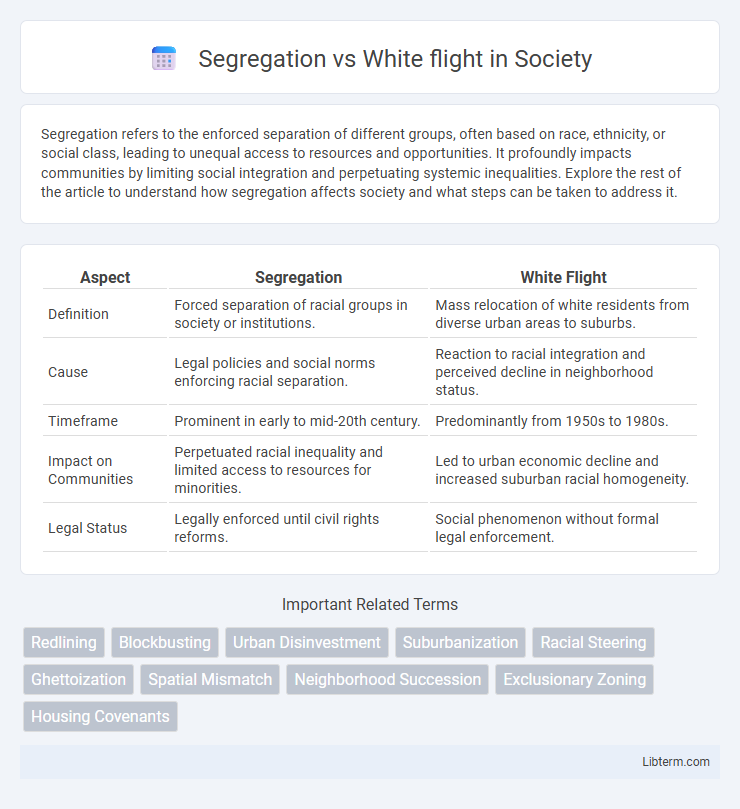Segregation refers to the enforced separation of different groups, often based on race, ethnicity, or social class, leading to unequal access to resources and opportunities. It profoundly impacts communities by limiting social integration and perpetuating systemic inequalities. Explore the rest of the article to understand how segregation affects society and what steps can be taken to address it.
Table of Comparison
| Aspect | Segregation | White Flight |
|---|---|---|
| Definition | Forced separation of racial groups in society or institutions. | Mass relocation of white residents from diverse urban areas to suburbs. |
| Cause | Legal policies and social norms enforcing racial separation. | Reaction to racial integration and perceived decline in neighborhood status. |
| Timeframe | Prominent in early to mid-20th century. | Predominantly from 1950s to 1980s. |
| Impact on Communities | Perpetuated racial inequality and limited access to resources for minorities. | Led to urban economic decline and increased suburban racial homogeneity. |
| Legal Status | Legally enforced until civil rights reforms. | Social phenomenon without formal legal enforcement. |
Understanding Segregation: Historical Context
Segregation in the United States historically stemmed from legal and social policies enforcing racial separation, particularly through Jim Crow laws and redlining practices that systematically marginalized African American communities. These policies entrenched racial disparities in housing, education, and employment, creating concentrated areas of poverty and limited economic opportunity for Black residents. Understanding this context is crucial to comprehending how segregation shaped urban demographics and the foundations of subsequent phenomena like White flight.
The Rise of White Flight in American Cities
The rise of white flight in American cities during the mid-20th century intensified urban segregation, as white residents relocated en masse to suburban areas in response to increasing racial integration and economic changes. This demographic shift was driven by factors such as redlining, discriminatory housing policies, and fears of declining property values, which exacerbated racial divides and economic disparities between urban and suburban populations. White flight contributed to the decline of inner cities, reducing investment and resources while reinforcing segregated communities through spatial separation.
Causes Behind Residential Segregation
Residential segregation stems from historical policies such as redlining, restrictive covenants, and discriminatory lending practices that systematically limited minority access to certain neighborhoods. White flight intensified segregation by prompting white residents to relocate to suburban areas following the racial integration of urban neighborhoods. Economic disparities and social stigmas further reinforced the separation of communities, perpetuating cycles of inequality within metropolitan regions.
How White Flight Transformed Urban Landscapes
White flight significantly transformed urban landscapes by accelerating suburbanization and altering demographic patterns in mid-20th century American cities. This migration led to disinvestment in urban centers, causing economic decline, decreased property values, and a surge in segregated neighborhoods predominantly occupied by minority communities. The resulting spatial segregation reinforced racial and economic divides, shaping the social and physical fabric of metropolitan regions.
Socioeconomic Impacts of Segregation and White Flight
Segregation and white flight significantly contribute to socioeconomic disparities by concentrating poverty and limiting access to quality education, employment opportunities, and social services in minority neighborhoods. White flight often leads to reduced tax bases and underfunded public resources, exacerbating neighborhood decline and perpetuating cycles of disadvantage. The resulting spatial separation reinforces systemic inequalities, hindering social mobility and economic integration.
Education Disparities: Segregation and White Flight
Educational disparities resulting from segregation and white flight manifest in uneven resource allocation and reduced academic opportunities for minority students. Segregation enforces concentration of poverty and underfunded schools, while white flight exacerbates disparities by depleting tax bases and increasing racial isolation in urban districts. These dynamics contribute to persistent achievement gaps and hinder equitable access to quality education across communities.
Government Policies Fueling Division
Government policies such as redlining, restrictive covenants, and discriminatory zoning laws systematically enforced racial segregation in urban areas, limiting minority access to quality housing and resources. These policies incentivized and facilitated white flight by creating economic and social pressures that drove white residents to suburban neighborhoods, further entrenching racial divisions. Federal programs like the FHA's biased mortgage lending practices reinforced these patterns by denying minorities equal homeownership opportunities, perpetuating segregated communities.
Segregation vs White Flight: Key Differences
Segregation refers to the enforced separation of racial or ethnic groups through laws or social systems, resulting in unequal access to resources and opportunities. White flight describes the mass migration of white residents from urban areas to suburbs, driven by factors such as desegregation and economic changes, which often perpetuates racial and economic segregation. The key difference lies in segregation being a structural and institutional practice, while white flight represents a demographic response to those practices and broader social dynamics.
Lasting Effects on Communities of Color
Segregation entrenched systemic inequalities by limiting access to quality education, employment, and housing for communities of color, reinforcing economic disparities. White flight exacerbated these effects by triggering disinvestment in urban neighborhoods, leading to deteriorating infrastructure and reduced public services. The combined impact of segregation and white flight has resulted in concentrated poverty, diminished wealth accumulation, and persistent social stratification in communities of color.
Moving Toward Integration: Solutions and Challenges
Efforts to move toward integration address the challenges posed by segregation and white flight through policies like inclusive zoning, affordable housing initiatives, and equitable school funding. Community engagement and enforcement of anti-discrimination laws are critical in fostering diverse neighborhoods and mitigating the socio-economic divides exacerbated by white flight. Persistent structural inequalities and resistance to change remain significant obstacles to achieving lasting integration in urban and suburban areas.
Segregation Infographic

 libterm.com
libterm.com